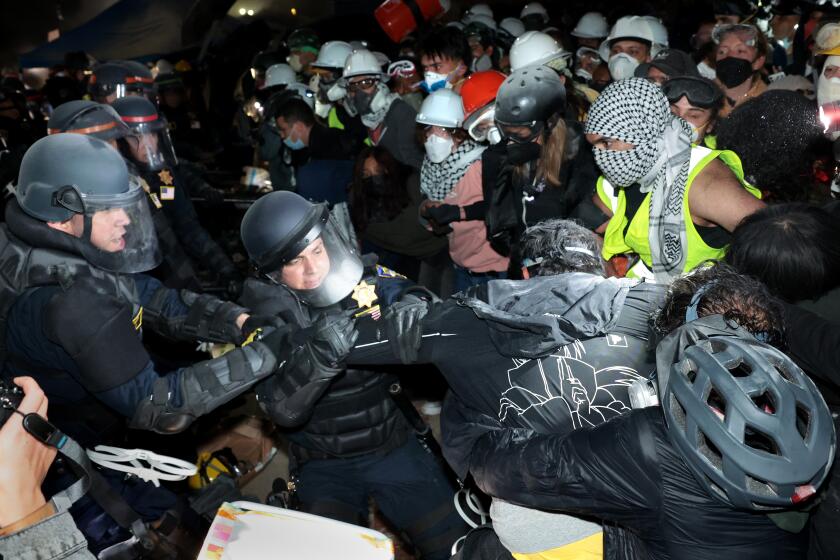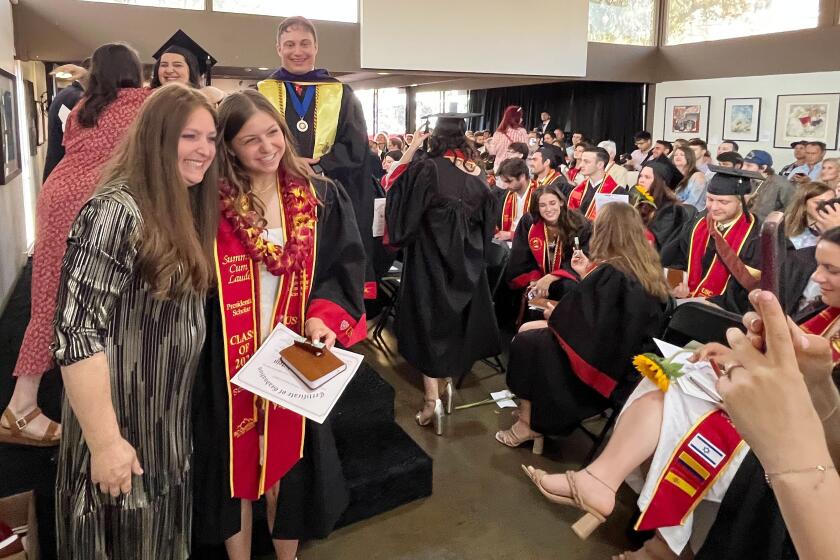USC seniors will help restore bells
Brian Barker wants to hear the long-silent carillon at USC’s bell tower once again sound the hour and play the school’s fight song. So Barker, an accounting major who graduates from USC on Friday, is raising money from classmates to restore and enhance the system of slender metal chimes.
“It’s one of the greatest feelings,” said Barker, who recalled hearing the USC chimes years ago before they fell into disrepair. “You get a sense of tradition.”
That tradition at USC is about to be revived with the help of another custom known as the senior class gift. At USC and other colleges and universities across the country, graduating classes raise money for such projects as new library desks, gardens or scholarship funds. For them, it’s a way to be remembered; for schools, it’s a chance to establish a pattern of generosity that campuses hope will last and grow.
This year, however, the gift-giving campaigns face challenges because of the recession. Burdened with student loan debt and worried about the job market, some seniors may not be in the mood to give to their alma mater. Fundraisers say they understand, and are asking graduating seniors to donate even modest amounts, perhaps $20.09 to match the class year -- or less.
“Everybody can afford two dollars or five dollars,” said Ryan Bentick, a USC religion major also involved in the carillon fundraiser. And if they don’t have cash, he and others say, a credit card is just fine.
A group of USC alumni women, the Town and Gown organization, recently donated $15,000 for basic repairs on the Von KleinSmid Center carillon, housed in the basement of a 167-foot-high tower in the middle of campus. The work is expected to be completed in time for the chimes to sound for Friday’s commencement.
The graduating seniors say they are on track to raise an additional $11,000 for supplemental chimes that will add harmony and color to the carillon’s music. That new sound is expected to debut for the first football game later this year.
About two-thirds of the class is expected to donate to the effort, USC officials said.
Other colleges around the country may not be quite as successful this year, but that won’t deter senior class efforts, said Rae Goldsmith, a philanthropy expert at the Washington-based Council for Advancement and Support of Education. The goal of such campaigns is not big dollars, but participation, she said, “to start the habit of giving.”
Goldsmith said research also has shown that seniors who contribute to a class gift are much more likely to make a donation in the future.
At Loyola Marymount University in Westchester, this year’s seniors are giving to a general fund that benefits scholarships, among other things. The number of gifts of $100 or more dropped this year and the average donation declined by more than half to about $15, probably because of job uncertainties. But with an emphasis on increasing the percentage of seniors who give, that rose from 36% of last year’s class to about 60% now, according to Bedford McIntosh, vice president for development and alumni relations.
To widen participation, UCLA switched five years ago from such tangible class gifts as vans and campus clocks to allowing seniors to contribute to various funds. About 25% of this year’s seniors are expected to donate something, down from the record high of 40% last year, but still strong compared with other recent years, said Melissa Bersofsky, UCLA’s director of Young Alumni and Senior Class Giving. Average gifts rose from $18 last year to about $24 now, for a total of $33,000 so far, she said.
Nationwide, many classes still choose to donate to physical projects, including some with an ecology theme. At Oberlin College in Ohio, seniors this year are contributing toward a student residence that is aimed at being carbon-neutral and for financial aid for students from Africa. Earlham College seniors in Indiana are funding a solar and wind energy project on a campus farm. Colorado College is planting a tree memorializing a faculty child killed in an accident.
At USC, restoring the carillon was first proposed by student government senator Shane Swerdlow, a junior who had heard of the chimes but never heard their music. Seniors voted on such gift options as a lamp post and a camp program for middle school children and chose the carillon, Barker said, because “this was something people could come back to campus to hear and say ‘I helped make that happen.’ ”
Because of various problems, the carillon has not played full songs for about 10 years and has not chimed as a regular time-keeper for about six years, said Brandon Operchuck, USC’s director of performance venues. Stored in a tiny basement room, the system is made up of sets of 151 narrow metal chimes that are played through a keyboard or by computerized programs.
Operchuck remembers the music from his days as a USC student. “It’s a beautiful sound,” he said. “In downtown L.A., where you hear planes and traffic and the freeway, the bells really bring something pleasant to that.”
However, to avoid repeating past complaints from professors about ringing interruptions to lectures, the chimes initially may sound just at noon and 5 p.m., and play songs on football game days and other special events, he said.
--
More to Read
Start your day right
Sign up for Essential California for news, features and recommendations from the L.A. Times and beyond in your inbox six days a week.
You may occasionally receive promotional content from the Los Angeles Times.







